Butterflies As Pollinators
 Butterflies pollinate during the day while most flowers are open and they have better color perception than bees or even humans, but they are less efficient than bees at moving pollen between plants. Their legs and proboscis are longer and farther away from the flower’s pollen so they do not pick up as much pollen on their bodies. They also lack specialized structures for collecting pollen. Nevertheless, it is hard to imagine that some of the Daylily pollen that has collected on this Eastern Tiger Swallowtail’s wings might not fall onto or be brushed against the stigma of the next Daylily it visits.
Butterflies pollinate during the day while most flowers are open and they have better color perception than bees or even humans, but they are less efficient than bees at moving pollen between plants. Their legs and proboscis are longer and farther away from the flower’s pollen so they do not pick up as much pollen on their bodies. They also lack specialized structures for collecting pollen. Nevertheless, it is hard to imagine that some of the Daylily pollen that has collected on this Eastern Tiger Swallowtail’s wings might not fall onto or be brushed against the stigma of the next Daylily it visits.
Naturally Curious is supported by donations. If you choose to contribute, you may go to http://www.naturallycuriouswithmaryholland.wordpress.com and click on the yellow “donate” button.
Lesser Purple Fringed Orchis Flowering

Approximately sixty orchids can be found in the Northeast, more than half of which are found growing in bogs and fens. (Bogs are filled with atmospheric moisture and have very low levels of nutrients; fens receive their water from streams or springs, and have slightly more nutrients than bogs.) In July and August in the Northeast, the Lesser Purple Fringed Orchis (Platanthera psycodes) sends up a 1 – 3’ spike filled with fragrant, tiny (3/4” long) flowers, each of which possesses a three-lobed, fringed lower lip and a long nectar spur . Found in cooler habitats, its range is being pushed northwards as global temperatures warm — a specimen was found at an altitude of 1,500 feet in Vermont. This orchid is on several states’ endangered or threatened lists outside of New England, and a species of special concern in Rhode Island. (Thanks to Shiela and Steven Swett for photo op.)
Naturally Curious is supported by donations. If you choose to contribute, you may go to http://www.naturallycuriouswithmaryholland.wordpress.com and click on the yellow “donate” button.
Bald Eagle Eyesight
 The eyesight of a Bald Eagle is impressive. Part of the reason for their excellent vision is that these birds of prey have two centers of focus (foveae), which allow them to see both forward and to the side at the same time. Cone cells, one of three types of photoreceptor cells in the retina, perceive color, fine detail and rapid movement. In a human, the fovea has 200,000 cones per millimeter; in the central fovea of a Bald Eagle’s eye, there are about a million cones per millimeter. An eagle’s eye is almost as large as a human’s, but its sharpness is at least four times that of a person with perfect vision.
The eyesight of a Bald Eagle is impressive. Part of the reason for their excellent vision is that these birds of prey have two centers of focus (foveae), which allow them to see both forward and to the side at the same time. Cone cells, one of three types of photoreceptor cells in the retina, perceive color, fine detail and rapid movement. In a human, the fovea has 200,000 cones per millimeter; in the central fovea of a Bald Eagle’s eye, there are about a million cones per millimeter. An eagle’s eye is almost as large as a human’s, but its sharpness is at least four times that of a person with perfect vision.
Bald eagles are capable of seeing fish in the water from several hundred feet above, while soaring, gliding or in flapping flight. (They locate and catch dead fish much more rapidly and efficiently than live fish, because dead fish float with their light underside up, making them easier to see.) It is very likely that a Bald Eagle can identify a rabbit moving almost a mile away. This would mean that an eagle flying at an altitude of 1000 feet over open country could spot prey over an area of almost 3 square miles from a fixed position. (photo: recently fledged, juvenile Bald Eagle)
Naturally Curious is supported by donations. If you choose to contribute, you may go to http://www.naturallycuriouswithmaryholland.wordpress.com and click on the yellow “donate” button.
Eastern Cottontail vs. New England Cottontail

There are two species of cottontails in the Northeast – the New England Cottontail and the Eastern Cottontail. The New England Cottontail was the only rabbit east of the Hudson River until the Eastern Cottontail was introduced in the late 1800s. Today the New England Cottontail is restricted to less than a fifth of its range in the early 1900s, whereas the Eastern Cottontail can be found throughout New England.
Although they are two separate species, these two rabbits look very similar – the Eastern Cottontail is slightly larger, has longer ears, and its eyes are half again as large as the New England Cottontail’s. The New England Cottontail is a forest species that depends on areas of thick shrubs and young trees that grow up following natural disturbances. A combination of dwindling habitat due to development, the ephemeral nature of young forests (they only last for 10 to 20 years before becoming older woodland, where ground-level plants are too thin to provide rabbits with enough food and cover to survive) and inferior eyesight has led to the dwindling population of New England Cottontails, and fostered the growth of the Eastern Cottontail population. Eastern Cottontails seem better able to survive in the increasingly fragmented habitats of New England, including open fields, forest edges, small thickets, and even golf courses and suburban lawns. (Photo: Eastern Cottontail)
Naturally Curious is supported by donations. If you choose to contribute, you may go to http://www.naturallycuriouswithmaryholland.wordpress.com and click on the yellow “donate” button.
Red-bellied Woodpeckers Sunning
 Red-bellied Woodpeckers have extended their breeding range northward and westward over the last 50 years and are now breeding in northern New England. Many are year-round residents here, while some individuals move further south during particularly harsh winters. This range extension allows for observations not possible even 10 or 20 years ago.
Red-bellied Woodpeckers have extended their breeding range northward and westward over the last 50 years and are now breeding in northern New England. Many are year-round residents here, while some individuals move further south during particularly harsh winters. This range extension allows for observations not possible even 10 or 20 years ago.
While watching a Red-bellied Woodpecker this summer, I witnessed behavior I had never observed before. The bird flew repeatedly to the same tree branch, flattened itself on the branch with its body facing the sun and then fanned its wings out while cocking its head, raising its crown feathers, opening its beak and appearing to look at the sun. This behavior is common enough to have a name – the woodpecker was “sunning” itself. While preening, stretching and calling often takes place intermittently while the bird is engaged in sunning, it may also enter a stupor or state of lethargy. (Thanks to Cindy Lawrence for photo op.)
Naturally Curious is supported by donations. If you choose to contribute, you may go to http://www.naturallycuriouswithmaryholland.wordpress.com and click on the yellow “donate” button.
American Caesar’s Mushroom Fruiting
 At the risk of boring readers with a repeat post, I seem unable to come across an American Caesar’s Mushroom without photographing it and somehow justifying its worthiness as a Naturally Curious post, even in consecutive years (a practice I try to avoid). Simply put, the beauty of this non-flowering fungus rivals that of any flowering plant I can think of.
At the risk of boring readers with a repeat post, I seem unable to come across an American Caesar’s Mushroom without photographing it and somehow justifying its worthiness as a Naturally Curious post, even in consecutive years (a practice I try to avoid). Simply put, the beauty of this non-flowering fungus rivals that of any flowering plant I can think of.
American Caesar’s Mushroom (Amanita jacksonii), a member of the Amanita genus found in New England, differs from most Amanita species in at least two ways. It is one of the few edible Amanitas (most species are poisonous, so consumption is discouraged unless an expert identifies the fungus). Secondly, unlike many other Amanita species, American Caesar’s Mushroom does not usually have any warts or patches on its cap.
The common name of this mushroom traces back to the fact that its close relative, Caesar’s Mushroom, Amanita caesarea, which grows in Italy, was a favorite of the emperors of the Roman Empire, the Caesars. Both of these species of Amanita are mycorrhizal, forming a symbiotic beneficial relationship with the roots of certain trees. Look for American Caesar’s Mushrooms under pine and oak. (photo: American Caesar’s Mushroom rupturing through its protective white membrane, or universal veil, as it matures, leaving a remnant white cup, or volva, at its base.)
Naturally Curious is supported by donations. If you choose to contribute, you may go to http://www.naturallycuriouswithmaryholland.wordpress.com and click on the yellow “donate” button.
Gypsy Moth Caterpillar Explosion
 The Gypsy Moth was introduced into the United States in 1869 by a French scientist living in Massachusetts. Since then its range has expanded to include the entire Northeast south to North Carolina and as far west as Minnesota and Iowa. The consequence of the introduction of this insect is staggering. According to the U.S. Dept. of Agriculture, since 1980, the Gypsy Moth has defoliated close to a million or more forested acres each year. In 1981, a record 12.9 million acres were defoliated. This is an area larger than Rhode Island, Massachusetts, and Connecticut combined.
The Gypsy Moth was introduced into the United States in 1869 by a French scientist living in Massachusetts. Since then its range has expanded to include the entire Northeast south to North Carolina and as far west as Minnesota and Iowa. The consequence of the introduction of this insect is staggering. According to the U.S. Dept. of Agriculture, since 1980, the Gypsy Moth has defoliated close to a million or more forested acres each year. In 1981, a record 12.9 million acres were defoliated. This is an area larger than Rhode Island, Massachusetts, and Connecticut combined.
The Gypsy Moth females lay their eggs, usually on host tree trunks, in late summer. The eggs overwinter and hatch in the spring. Gypsy Moth caterpillars feed on a variety of species of shrubs and trees, with White Oak being their preferred host, metamorphose, mate and repeat this process. Usually their numbers are not overwhelming, but due to the weather conditions we’ve been experiencing, the caterpillar population has skyrocketed in some areas, especially in southern New England.
Conditions were very dry in parts of New England in May 2014 and May 2015, which impeded the growth of a certain kind of Japanese fungus (Entomophaga maimaiga) that keeps the Gypsy Moth caterpillar population under control. Without this fungus present to keep their numbers in check, Gypsy Moths have flourished. Although there was some rain this spring, there were many areas that did not get enough to benefit the fungus, and in these areas, trees are now stripped of their leaves. It is possible in places in southern New England to track the pattern of rainfall simply by looking at where trees are still in full leaf. Fortunately, the time has come for Gypsy Moth caterpillars to pupate, so most of this year’s destruction has already occurred. Here’s hoping for a rainy May next year.
Naturally Curious is supported by donations. If you choose to contribute, you may go to http://www.naturallycuriouswithmaryholland.wordpress.com and click on the yellow “donate” button.
Common Loon Chicks Growing & Acquiring Survival Skills
 A great deal of learning is packed into a Common Loon chick’s first week. It learns to ride on its parents’ backs as well as crawl under their wings, a necessity due to its vulnerability, lack of maneuverability, inability to regulate its body temperature. Communication skills are practiced, with soft “mewing” elicited when a chick is hungry or in need of attention. The act of preening begins, and the chick successfully retrieves small fish and crayfish from its parents’ beaks.
A great deal of learning is packed into a Common Loon chick’s first week. It learns to ride on its parents’ backs as well as crawl under their wings, a necessity due to its vulnerability, lack of maneuverability, inability to regulate its body temperature. Communication skills are practiced, with soft “mewing” elicited when a chick is hungry or in need of attention. The act of preening begins, and the chick successfully retrieves small fish and crayfish from its parents’ beaks.
By the second week, Common Loon chicks are still fluffy balls of down, but they molt a second time, after which they are a much lighter brown. They dismount from their parents frequently and motor around under their own steam, usually staying very close to a parent. By the time they are ten days old, their hitchhiking days are over for the most part, and they are on their own when it comes to getting from one place to another. The eleven-day-old Common Loon chicks pictured are just starting to make shallow dives at this point in their development, but still depend largely on meal delivery from their parents. In another month, they’ll be catching most of their meals themselves, although their catches will be supplemented with food provided by the parents. In two months their flight, as well as contour, feathers will have replaced their down feathers, and within a couple more weeks of that happening, they will be capable of flight.
(The next Naturally Curious post will be on 7/18/16.)
Naturally Curious is supported by donations. If you choose to contribute, you may go to http://www.naturallycuriouswithmaryholland.wordpress.com and click on the yellow “donate” button.
All In A Day’s Post
 Every day I head out with the hope of finding something interesting enough to write about and share on my blog, and which I can also manage to photograph. There are days when it happens within minutes, but typically it consumes the better part of half a day. I thought I would take this opportunity to try and convey the sensory experience of this endeavor by describing yesterday’s outing.
Every day I head out with the hope of finding something interesting enough to write about and share on my blog, and which I can also manage to photograph. There are days when it happens within minutes, but typically it consumes the better part of half a day. I thought I would take this opportunity to try and convey the sensory experience of this endeavor by describing yesterday’s outing.
I arrive at the beaver pond late in the afternoon, hoping for a glimpse of the two beaver kits that have been seen here in recent days. Hidden behind ferns and shaded by young white pines, I set up my tripod and camera and settle down, hoping my arrival has not been observed. I am accompanied by Emma, my lab, who for 12 years has patiently sat by my side motionless as we waited for the expected and unexpected to present itself. The sun is close to disappearing behind the trees, but lingering light provides a warm glow to the pond.
Silence greets me, but not for long. There is no sign of beavers, but I am serenaded by a lone Hermit Thrush, bidding a sweet goodnight to the surrounding woods and all who reside therein. Soon after the Hermit Thrush’s flute-like song ceases, a chorus of plunking Green Frogs starts up. Still no beavers, but I hear a splash from a corner of the pond that is hidden from view, and out flies a Broad-winged Hawk, whose empty talons tell the tale of a failed attempt to catch a frog or other aquatic resident. I suddenly hear the high-pitched whining of young beavers coming from within the lodge that is roughly 150 feet directly across the pond from where I sit. This often occurs when a parent leaves the lodge, so I am on high alert. Cedar Waxwings appear, perching on snags and flying out over the pond to snatch insects from a recent hatch before returning to their perch.
The sun is all but gone as a lone adult beaver surfaces and heads to the far end of the pond. As silently as possible I walk along the side of the pond until I hear the familiar sound of rodent incisors gnawing rapidly on wood. There, at the shoreline, the beaver is cutting a branch off a limb of a sloping tree that is within its reach. Soon the chewing stops and the beaver grasps the cut branch in its mouth and swims the length of the pond to the lodge where its young eagerly await a freshly-cut meal. When it gets to within several feet of the lodge, the beaver silently disappears beneath the water and moments later is greeted with the exuberant, anticipatory whining of its offspring. With luck, I may have captured more than one post’s photograph, but even if I haven’t, my ears and eyes (and soul) have reaped enormous benefit from the effort.
Naturally Curious is supported by donations. If you choose to contribute, you may go to http://www.naturallycuriouswithmaryholland.wordpress.com and click on the yellow “donate” button.
Attracting Fruit-eating Birds
 There are many birds, such as waxwings, that have a frugivorous (strictly fruit-eating) diet. The only time they usually expand their diet to include insects is during the breeding season, when growing hatchlings require high amounts of protein for proper development. Others, such as orioles, show a marked preference for fruit but also eat significant quantities of other foods. All of these birds play an important role by spreading fruit seeds to distant areas either by caching food or distributing the seeds through their droppings.
There are many birds, such as waxwings, that have a frugivorous (strictly fruit-eating) diet. The only time they usually expand their diet to include insects is during the breeding season, when growing hatchlings require high amounts of protein for proper development. Others, such as orioles, show a marked preference for fruit but also eat significant quantities of other foods. All of these birds play an important role by spreading fruit seeds to distant areas either by caching food or distributing the seeds through their droppings.
Bird lovers often put out seed to lure birds in for a closer look (a practice discouraged during the summer in black bear country), but there is an equally effective magnet for some species, and that is fruit. (Due to the high sugar content, little nutrition and potential bacteria growth in jelly, it may be best to provide fruit over jelly.) Grapes often attract Northern Mockingbirds, Eastern Bluebirds, Cedar Waxwings, Gray Catbirds, Scarlet Tanagers, Rose-breasted Grosbeaks, House Finches and American Robins. Raisins and currants (soaked in water overnight) appeal to Northern Mockingbirds, Gray Catbirds, Eastern Bluebirds, Cedar Waxwings and Eastern Towhees. Species that find orange halves hard to resist include Red-bellied Woodpeckers, Northern Mockingbirds, Brown Thrashers, Baltimore Orioles, Scarlet Tanagers, Gray Catbirds and Rose-breasted Grosbeaks. (Photo: Gray Catbird (left), female Red-bellied Woodpecker (middle) and female Baltimore Oriole (right) enjoying breakfast at The House On The Hill Bed & Breakfast, Greenfield, MA.)
Naturally Curious is supported by donations. If you choose to contribute, you may go to http://www.naturallycuriouswithmaryholland.wordpress.com and click on the yellow “donate” button.
Dogbane Beetles Emerging & Mating
 After feeding on Dogbane (Apocynum cannabinum) roots and overwintering underground, larval Dogbane Beetles pupate and emerge in early summer, shortly after the Dogbane plant for which they were named begins to flower. It’s hard to miss these iridescent beetles as they gather to feed on Dogbane leaves (which are poisonous to many creatures, including humans, and can cause cardiac arrest). Soon after the adult beetles emerge from the soil , they mate, usually about once a day, frequently early in the day. Males search for and choose females to mate with. Dogbane beetles often have more than one mate, so after breeding, males ride on the backs of the females to guard them from other suitors (see photo insert).
After feeding on Dogbane (Apocynum cannabinum) roots and overwintering underground, larval Dogbane Beetles pupate and emerge in early summer, shortly after the Dogbane plant for which they were named begins to flower. It’s hard to miss these iridescent beetles as they gather to feed on Dogbane leaves (which are poisonous to many creatures, including humans, and can cause cardiac arrest). Soon after the adult beetles emerge from the soil , they mate, usually about once a day, frequently early in the day. Males search for and choose females to mate with. Dogbane beetles often have more than one mate, so after breeding, males ride on the backs of the females to guard them from other suitors (see photo insert).
Naturally Curious is supported by donations. If you choose to contribute, you may go to http://www.naturallycuriouswithmaryholland.wordpress.com and click on the yellow “donate” button.
Young Raccoons Leaving Natal Dens
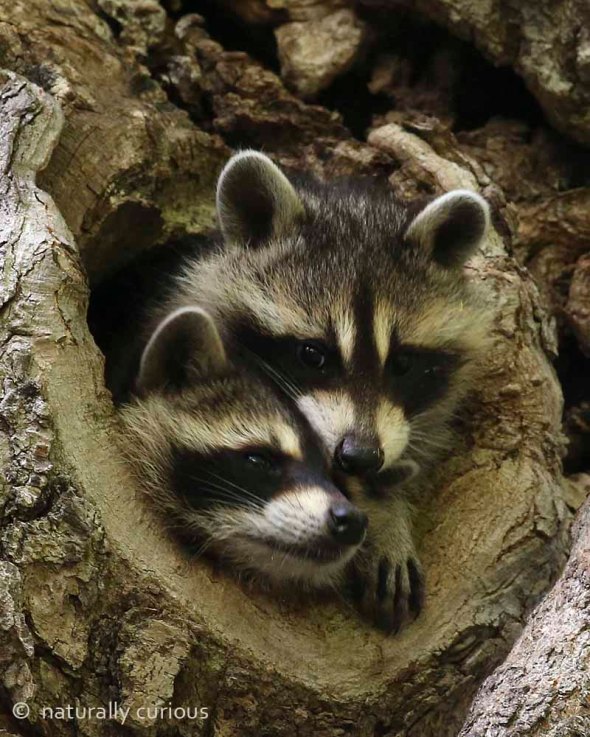 Most raccoons in the Northeast are born in April or early May and spend the next seven weeks inside a tree cavity (brush piles and underground burrows are known but not prevalent denning sites) living off their mother’s milk. Four to six weeks go by before the young are able to stand upright, but soon thereafter they are climbing and hanging out of the cavity entrance. The young raccoons are in the process of being weaned when they leave their den at the age of seven weeks. For the next month or so the mother raccoon and her offspring forage together; by the age of five months the young are doing a lot of foraging on their own. Often the family remains together into the late fall or even winter. During cold winter weather, they typically will den together, and the following spring when the new litter arrives, the one-year-old raccoons disperse. (Thanks to Andrea Ambros for photo op.)
Most raccoons in the Northeast are born in April or early May and spend the next seven weeks inside a tree cavity (brush piles and underground burrows are known but not prevalent denning sites) living off their mother’s milk. Four to six weeks go by before the young are able to stand upright, but soon thereafter they are climbing and hanging out of the cavity entrance. The young raccoons are in the process of being weaned when they leave their den at the age of seven weeks. For the next month or so the mother raccoon and her offspring forage together; by the age of five months the young are doing a lot of foraging on their own. Often the family remains together into the late fall or even winter. During cold winter weather, they typically will den together, and the following spring when the new litter arrives, the one-year-old raccoons disperse. (Thanks to Andrea Ambros for photo op.)
Naturally Curious is supported by donations. If you choose to contribute, you may go to http://www.naturallycuriouswithmaryholland.wordpress.com and click on the yellow “donate” button.
Shinleaf Flowering
 The evergreen perennial Shinleaf (Pyrola elliptica) is often only noticed at this time of year, when it is flowering. The flower is distinctive in that the prominent style of the female pistil is proportionally far longer than in most flowers, and extends beyond the waxy, white petals. The common name — Shinleaf — is a reference to the medicinal properties of the plant. It contains a drug closely related to aspirin; the leaves reportedly have analgesic properties and were used as a poultice on bruised shins and other sores and wounds.
The evergreen perennial Shinleaf (Pyrola elliptica) is often only noticed at this time of year, when it is flowering. The flower is distinctive in that the prominent style of the female pistil is proportionally far longer than in most flowers, and extends beyond the waxy, white petals. The common name — Shinleaf — is a reference to the medicinal properties of the plant. It contains a drug closely related to aspirin; the leaves reportedly have analgesic properties and were used as a poultice on bruised shins and other sores and wounds.
There are several species of pyrolas and they vary in leaf shape and flower color/arrangement. All of them belong to the family Ericaceae, which includes blueberries and cranberries.
Look for this four to twelve-inch plant in shady, damp woods and when you find one, peer up under the petals to see the orange-tipped male stamens.
Naturally Curious is supported by donations. If you choose to contribute, you may go to http://www.naturallycuriouswithmaryholland.wordpress.com and click on the yellow “donate” button.
White Admirals Mating
 For several weeks White Admiral butterflies have been a common sight along dirt roads, where they obtain nutrients from damp soil. They are a kind of “brush-footed butterfly,” having reduced forelegs that are folded up and often bear a brush-like set of hairs. Like most other butterflies in their genus (Limenitis), White Admirals fly with alternating quick wingbeats and flat-winged glides. It is not unusual to see males perched on trees along trails or forest clearings, waiting for females to come along.
For several weeks White Admiral butterflies have been a common sight along dirt roads, where they obtain nutrients from damp soil. They are a kind of “brush-footed butterfly,” having reduced forelegs that are folded up and often bear a brush-like set of hairs. Like most other butterflies in their genus (Limenitis), White Admirals fly with alternating quick wingbeats and flat-winged glides. It is not unusual to see males perched on trees along trails or forest clearings, waiting for females to come along.
After years of White Admirals and Red-spotted Purples being classified as different species, they are now considered to be one and the same species, even though their appearance is quite different. (Red-spotted Purples lack the bold white banding on their wings that helps break up the outline of White Admirals.) Where their ranges overlap, which includes New England, individuals with characteristics of both of these butterflies are seen with some regularity. Look for White Admirals, Red-spotted Purples and intermediates feeding on rotting fruit, in dirt roads, scat and flowers throughout the Northeast.
Naturally Curious is supported by donations. If you choose to contribute, you may go to http://www.naturallycuriouswithmaryholland.wordpress.com and click on the yellow “donate” button.
 A Gray Treefrog starts life off as a ¼” yellow tadpole. Eventually it may reach 2 ½” in length, and its body will have turned olive green with a red tail. Upon metamorphosing into a frog, the Gray Treefrog turns a bright emerald green and gradually develops into a mottled greenish-gray adult which can change its color from green to gray in about half an hour to match its environment. The two color phases of the maturing frog (solid green of the young, and mottled gray or green of adult) are so different it’s hard to believe that they are the same species. (Photo: young Gray Treefrog; insert- adult Gray Treefrog)
A Gray Treefrog starts life off as a ¼” yellow tadpole. Eventually it may reach 2 ½” in length, and its body will have turned olive green with a red tail. Upon metamorphosing into a frog, the Gray Treefrog turns a bright emerald green and gradually develops into a mottled greenish-gray adult which can change its color from green to gray in about half an hour to match its environment. The two color phases of the maturing frog (solid green of the young, and mottled gray or green of adult) are so different it’s hard to believe that they are the same species. (Photo: young Gray Treefrog; insert- adult Gray Treefrog)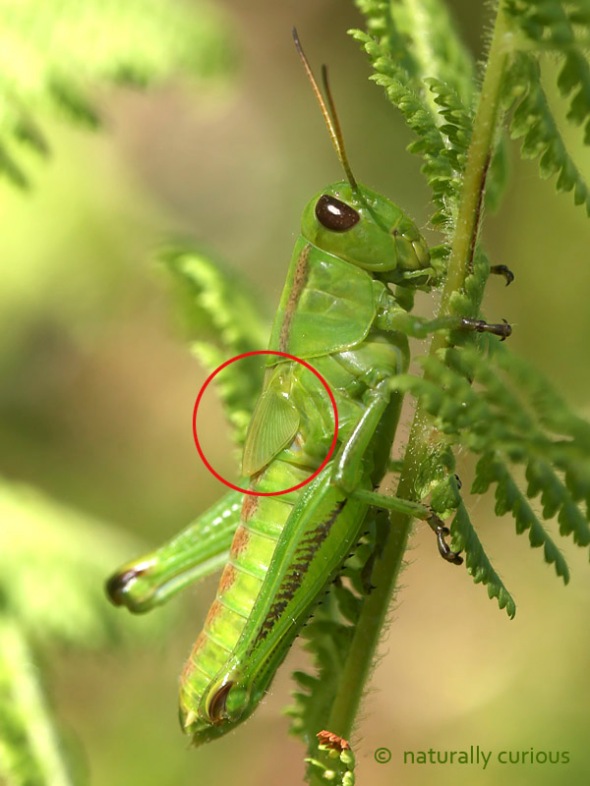 Grasshoppers experience incomplete metamorphosis, with three life cycle stages – egg, nymph, and adult. A grasshopper egg hatches into a nymph, which resembles an adult grasshopper, except that it is smaller and lacks wings and reproductive organs. Because of its hard outer exoskeleton, a growing grasshopper has to shed its skin periodically to accommodate its increased size. (A larger exoskeleton develops beneath the old, smaller one that is shed.) Grasshopper nymphs molt several times (each stage between molts is referred to as an instar) before they reach their adult size, and with each molt, their “wing buds” get larger. After the final molt, the wings are inflated and become fully functional. Wings play an important part in grasshopper courtship, as males “sing” to attract females by rapidly rasping their leg against their forewing, a process called stridulation.
Grasshoppers experience incomplete metamorphosis, with three life cycle stages – egg, nymph, and adult. A grasshopper egg hatches into a nymph, which resembles an adult grasshopper, except that it is smaller and lacks wings and reproductive organs. Because of its hard outer exoskeleton, a growing grasshopper has to shed its skin periodically to accommodate its increased size. (A larger exoskeleton develops beneath the old, smaller one that is shed.) Grasshopper nymphs molt several times (each stage between molts is referred to as an instar) before they reach their adult size, and with each molt, their “wing buds” get larger. After the final molt, the wings are inflated and become fully functional. Wings play an important part in grasshopper courtship, as males “sing” to attract females by rapidly rasping their leg against their forewing, a process called stridulation.





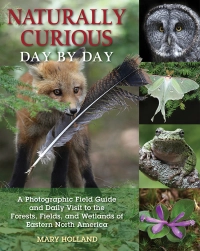
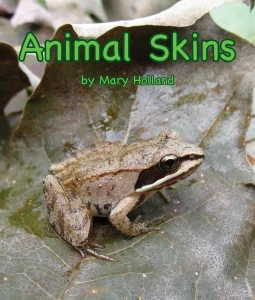
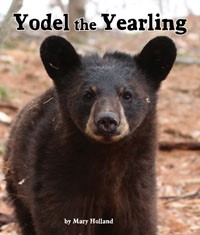


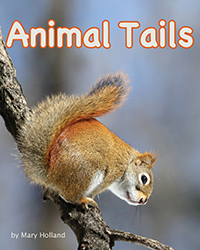
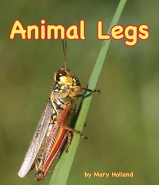
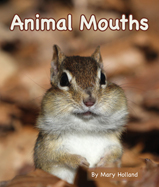






What Other Naturally Curious People Are Saying